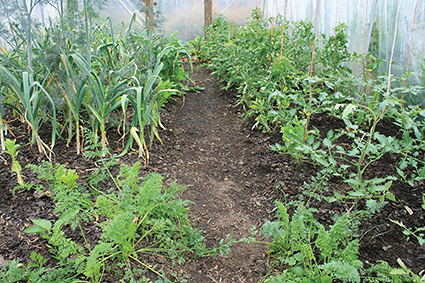‘Rain in June keeps all in tune’ is true up to a point. Last year heavy June rain produced huge crops of potatoes and broad beans. My father’s comment that ‘we need rain, but only in some fields’ came true again: good for potatoes but not enough sunshine and warmth for other crops like runner beans and courgettes. This year has been pretty good—so far.
As so often we transplanted our French and runner beans as early as we dared, hoping they can grow strongly away from slug attack. Fleecing over until they badly need canes to grow up helps establish them.
Our early outdoor sowings of carrots and broad beans failed this year under sheer pressure of predators combined with the cold, whereas my early May sowing of carrots came up in a fortnight, helped by constant watering of the top soil layer when dry.
Nip out broad bean tops as soon as you see the first blackfly, dib leeks at the end of the month, and put lots of compost around established plants to both mulch and feed them.
As gaps appear, sow or transplant beetroot, French beans, carrots, lettuce, winter brassicas such as swede, winter cabbage, sprouts, cauliflower, calabrese and broccoli and, after the solstice, bulb Florence fennel, radicchio and endives. This year Real Seeds have sold me mixed packet of spring cauliflower seed, this may help spread the harvest period next spring.
Red sky at night, shepherds delight. Red sky in a mist, shepherds pissed.

A busy hoop house in mid May. In the left bed: peppers sown mid-Feb, still small and normally under fleece, transplanted after pulling a crop of peas sown November that produced pods right through April. Garlic was planted early December between rows of salad to deter slugs—it helped a bit(!)—between rows of now-tall overwintered salad lettuce, spinach and dill—some still being picked, and which will be kept for seed. The garlic will be ready to harvest by the end of May. Between the garlic are some cucumber and melon plants just transplanted. A self-sown parsnip has been left to see how big it grows, with French beans beyond that should be ready to eat through June. The right bed is mainly tomatoes sown mid-Feb. Between them some beetroot sown mid-Feb now being picked, and radish also a good size only 6 weeks after sowing. In the foreground a few last carrots (Autumn King) sown October and now a good size. All this intercropping seems to work well even if a bit chaotic, definitely more productive. I will be planting squash under the tomatoes in June, which makes for added but irresistible chaos, last year this produced 40kg butternut off 3 plants.




